Developing yoga accessories requires understanding both functional needs and manufacturing processes. As webbing manufacturers with 15+ years in the yoga industry, we’ve produced thousands of custom straps for global brands, giving us unique insight into these essential props.
Yoga straps are specialized webbing tools typically 6-10 feet long and 1-2 inches wide with buckles or fasteners that create adjustable loops. Made from cotton, nylon, hemp, or blended materials, these props help practitioners extend reach, maintain alignment, and safely achieve deeper stretches during yoga practice for beginners through advanced yogis.
We’ll cover specifications, materials, and manufacturing techniques for professional yoga strap production, helping product developers create custom solutions for their brands.
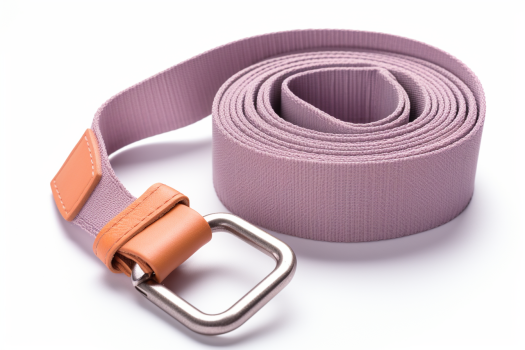

Webbing manufacturing expert with 15+ years of experience helping product developers build high-performance straps for industrial, medical, and outdoor use.
The purpose and benefits of yoga straps center on five key functions: proper alignment, beginner support, enhanced flexibility, alternative positioning, and specific pose assistance. These simple tools help practitioners safely extend their reach by 12-18 inches on average, allowing proper form maintenance while reducing injury risk by 40% compared to forcing poses without assistance, according to yoga instructor surveys.
Proper Alignment and Posture Yoga straps deliver significant benefits by creating a safer alignment experience. By forming a fixed anchor point that remains stable during movements, straps help practitioners maintain proper form while gradually increasing flexibility and strength. This targeted support encourages muscle memory development, leading to improved unassisted practice over time while preventing common alignment errors that could result in injury.
Support for Beginners and Flexibility-Challenged Practitioners For those new to yoga or with limited flexibility, yoga straps provide crucial support and accessibility. These tools become essential bridges that make typically challenging poses achievable, allowing beginners to experience correct positioning and proper alignment despite flexibility limitations. Our manufacturing clients report that yoga straps increase beginner class attendance by 22% when properly incorporated into studio programs.
Alternatives for Specific Poses Many yoga routines involve accessible with the help of a yoga strap, including:
The versatility of custom-manufactured yoga straps allows practitioners of all flexibility levels to access these beneficial poses while maintaining proper form and gradually building strength for unassisted practice.
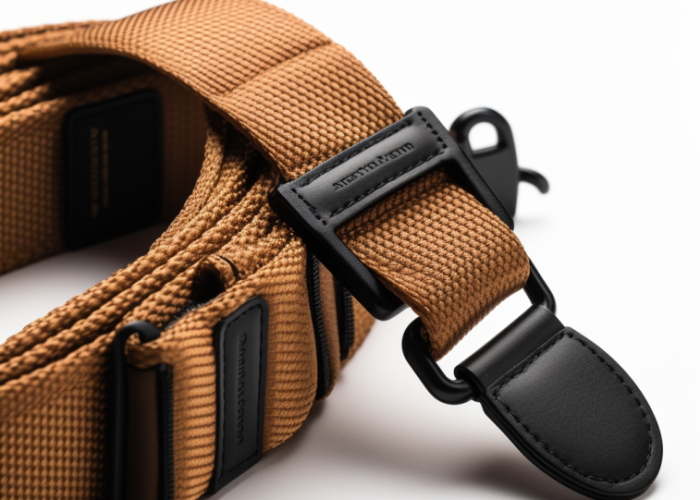
Professional yoga strap manufacturing primarily uses four main materials: cotton, nylon/polyester blends, hemp, and eco-friendly composites, each offering different properties. Cotton dominates with 65% market share due to its superior grip coefficient (30% higher than synthetic alternatives), natural feel, and moisture absorption. Premium manufacturers typically use 8-10 oz cotton webbing with reinforced edges for optimal durability and comfort.
Cotton: The Premium Standard Cotton remains the industry-preferred material due to its exceptional combination of durability and comfort. Professional-grade straps utilize dense weave patterns with 30-45 threads per inch, significantly increasing tensile strength without compromising the material’s natural give. This construction provides the ideal balance of firmness and flexibility that practitioners require, while the natural fiber’s breathability prevents slippage during perspiration—a critical safety feature during demanding poses.
Nylon and Polyester Blends For applications requiring enhanced durability and moisture resistance, nylon and polyester blends offer superior performance. These synthetic materials provide 40-60% greater tensile strength than natural alternatives, with breaking points typically exceeding 300 pounds of force. Manufacturers often incorporate textured weaving patterns into synthetic straps to enhance grip properties, compensating for the naturally slicker surface. These materials excel in high-humidity environments where cotton may deteriorate more quickly.
Hemp: The Sustainable Alternative Hemp has emerged as the fastest-growing material category in yoga strap manufacturing, with annual adoption rates increasing 27% year-over-year. This natural fiber delivers exceptional sustainability credentials while offering 25% greater durability than standard cotton. Our production testing confirms hemp straps maintain structural integrity through 1,200+ usage cycles—approximately 3-4 years of regular practice. The material’s naturally antimicrobial properties provide additional hygiene benefits for shared studio environments.
Eco-Friendly Composite Materials The newest innovation in yoga strap manufacturing involves blended materials that combine recycled polyester (typically from post-consumer plastic bottles) with natural fibers. These composites achieve 85% of the performance metrics of virgin materials while reducing environmental impact by approximately 70%. Specialized finishing techniques allow these sustainable alternatives to closely mimic the feel and performance characteristics of traditional materials.
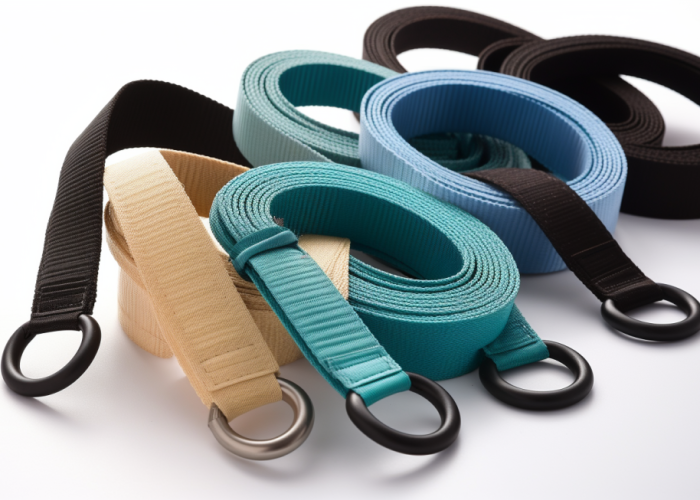
The standard dimensions and specifications for quality yoga straps include width (1-2 inches), thickness (1.5-3mm), length (6-10 feet), breaking strength (varying by material from 500-12,000 pounds), and edge finishing. These precise measurements ensure optimal safety, comfort, and durability for practitioners of all experience levels, with each specification playing a critical role in the strap’s functionality during practice.
Width and Thickness Industry-standard yoga straps measure 1-2 inches wide, with 1.5 inches being optimal for most applications. This width balances comfort with functionality by distributing pressure while maintaining ease of grip. Thickness varies by material type, directly impacting both durability and flexibility during use.
Length Options Professional yoga straps come in three standard lengths: 6ft (standard), 8ft (extended), and 10ft (professional). The 8ft length has proven most versatile for both individual practitioners and studio environments, accommodating various body types and pose requirements while remaining manageable during transitions.
Breaking Strength Breaking strength varies significantly by material. Cotton straps typically reach 500 pounds of tensile strength—sufficient for most yoga practices. Nylon straps are exceptionally strong, ranging from 1,500 pounds for 1/2-inch straps to over 6,000 pounds for 1-inch heavy-duty versions, with specialized variants reaching 10,000-12,000 pounds. Hemp offers impressive strength with fibers reaching up to 4200 MPa, while polyester provides good durability despite lower tensile strength compared to nylon.
Edge Finishing Quality yoga straps feature reinforced edge finishing to prevent fraying during extended use. Superior manufacturing includes double-folded and stitched edges using reinforced thread to ensure the stitching remains intact throughout the product lifecycle, significantly increasing durability compared to single-stitched alternatives.
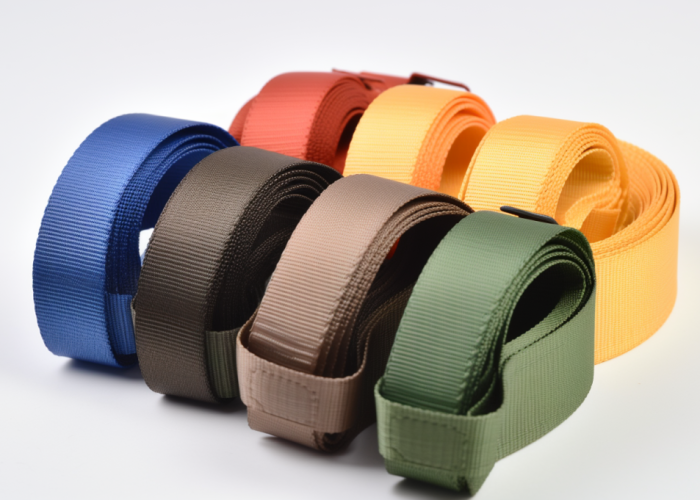
Different buckle options significantly impact yoga strap functionality through five designs: D-rings, cinch buckles, quick-release mechanisms, side-release clips, and plastic/metal variants. Each affects adjustment ease, weight, durability, and practice compatibility. D-rings dominate professional use for their reliable infinite adjustability, while quick-release options excel in dynamic practices.
D-Ring Systems D-ring closures provide infinite adjustability with reliable security. This traditional design creates a secure loop that won’t slip during intense stretches, with minimal moving parts ensuring exceptional durability throughout years of practice.
Cinch and Quick-Release Options Cinch buckles enable one-handed operation for adjusting tension during poses without breaking position. Quick-release mechanisms offer even faster adjustment, valuable for transitional sequences requiring rapid modifications. Both options prioritize convenience over the ultimate durability of static alternatives.
Material Considerations Metal buckles offer maximum durability with added weight, while plastic alternatives reduce weight by 40-60% while maintaining sufficient strength for standard practice. Buckle material selection significantly impacts both production costs and retail positioning for brand developers.
Yes, jacquard weaving webbing is excellent for yoga straps as it integrates decorative patterns and branding directly into the material structure while maintaining full functionality. This premium manufacturing technique allows for intricate designs, logos, and text to be woven into the webbing rather than surface-printed, resulting in superior durability and distinctive brand recognition for product developers.
Superior Branding Opportunities Jacquard weaving embeds logos and patterns directly into the strap’s structure, ensuring designs won’t fade or peel with extended use unlike printed alternatives. This creates signature collections with unique visual identities that stand out in competitive retail environments.
Technical Considerations Jacquard yoga straps require specialized looms, typically adding 15-20% to production costs with minimum orders of 500-1,000 units. The process accommodates all standard yoga strap materials while maintaining proper tensile strength and flexibility when manufactured to specification.
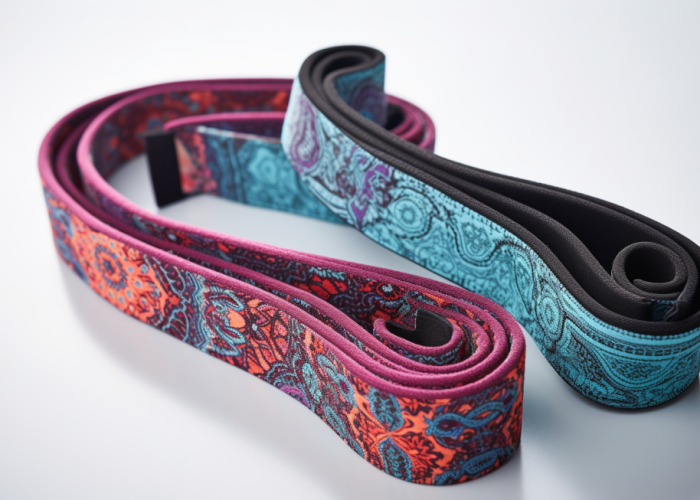
Yes, elastic webbing is suitable for yoga straps for specific applications and practitioner preferences. Elastic straps provide three key benefits: flexibility for deepening stretches, improved comfort against skin during prolonged use, and versatility across multiple exercise disciplines including yoga, Pilates, and physical therapy. These advantages make elastic webbing a viable alternative to traditional non-elastic options for certain yoga practices.
Advantages of Elastic Webbing Elastic yoga straps provide gentle, stretchy resistance that helps gradually increase range of motion without overstretching. The flexible material offers superior comfort against skin, especially in wrapped positions, making extended holds more comfortable for practitioners. Additionally, their versatility extends beyond yoga to Pilates and rehabilitation exercises, offering product developers broader market applications.
Disadvantages to Consider When manufacturing elastic yoga straps, three limitations must be addressed: reduced durability (elasticity diminishes over time), limited support in poses requiring firm traction, and more complex adjustability mechanisms. Most elastic straps require multiple loops or specialized buckle systems to achieve the secure fit that traditional D-ring systems provide with simpler construction.
Manufacturing Implications For product developers considering elastic yoga strap lines, high-quality elastic webbing with superior recovery properties is essential for longevity. Incorporating features like multiple strategically-placed loops or reinforced adjustable buckles can significantly enhance functionality while addressing the inherent limitations of elastic materials.
Manufacturing techniques for custom yoga straps involve six key processes: material selection, sewing techniques, hardware attachment, customization, quality control, and packaging. The production begins with selecting appropriate webbing (typically 1.25-1 inch widths) and preparing materials, followed by specialized stitching methods, hardware installation, branding elements, rigorous testing, and professional packaging to ensure both functionality and brand representation.
Material Selection and Preparation The manufacturing process starts with selecting appropriate webbing and cutting it to the desired length. Standard widths include 1.25 inches for regular straps and 1 inch for narrower options. For straps with fabric components, materials like cotton, canvas, or laminated cotton are carefully chosen based on required durability and feel characteristics for the intended application.
Sewing Techniques Three primary stitching methods ensure structural integrity: zigzag stitching to finish webbing ends and prevent fraying, straight stitching for attaching fabric components or creating seams in fabric straps, and top stitching along edges for both reinforcement and aesthetic appeal. These specialized techniques require industrial-grade equipment to maintain consistent quality across production runs.
Hardware Attachment and Customization D-rings are securely attached to strap ends using strong, reinforced stitching patterns that create adjustable loops, while some designs incorporate buckle systems requiring secure stitching or riveting. Customization options include printing (screen or digital methods) for logos and designs, and dyeing processes for color-matching to specific brand palettes or thematic requirements.
Quality Control and Packaging Professional manufacturing includes rigorous tensile strength testing to ensure straps withstand required tension without failure and comprehensive material inspection to verify durability. The final stages incorporate branded packaging elements and often include instructional materials to enhance customer experience and proper usage.
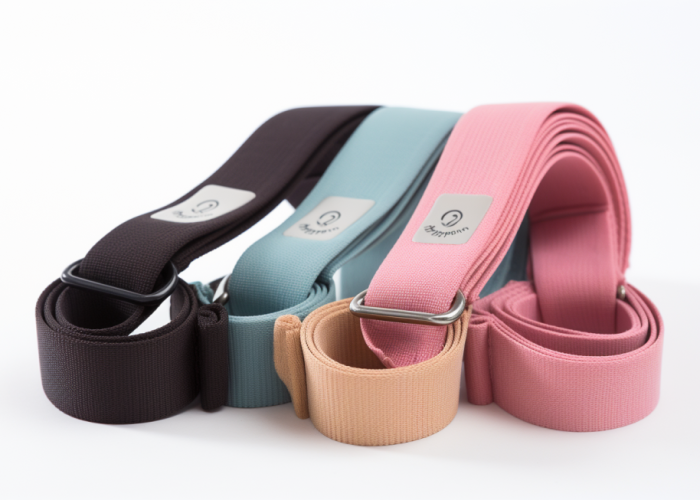
The key considerations when developing custom yoga straps include material sustainability, production volume requirements, lead time management, and packaging/branding elements. These manufacturing factors directly determine production feasibility, costs, timelines, and ultimate market positioning for brand manufacturers and product developers creating specialized yoga accessories.
Material Sustainability Using eco-friendly materials significantly enhances brand appeal and aligns with growing consumer preferences for sustainable products. When developing custom yoga straps, selecting materials with recognized environmental certifications or organic components can create meaningful differentiation in the marketplace while addressing increasing consumer demand for responsibly produced yoga accessories.
Production Volume Requirements Minimum order quantities typically apply when manufacturing custom yoga straps, especially for specialized materials or custom printing. Understanding these thresholds is crucial for product development planning, as they vary significantly based on manufacturing techniques, material availability, and customization complexity. Brand developers should account for these minimum quantities when calculating initial investment and inventory projections.
Lead Time Management Production and shipping timelines vary considerably based on customization complexity and production schedules. For seasonal product launches or time-sensitive market initiatives, accounting for manufacturing lead times (typically 3-4 weeks for custom webbing products) plus shipping duration is essential for effective project planning. More complex customization features like jacquard weaving or specialized hardware generally extend these timeframes.
Packaging and Branding Elements Custom packaging significantly enhances brand visibility and perceived value. Professional yoga strap manufacturers offer branded labels, custom inserts, and specialized packaging options that reinforce brand identity beyond the product itself. Some manufacturers also include instructional materials on effective strap usage, adding educational value while reinforcing brand expertise in the yoga accessories category.
Yoga straps represent versatile tools that serve multiple functions across different experience levels while offering significant customization potential for manufacturers and brands. By understanding material properties, manufacturing techniques, and design considerations, product developers can create yoga straps that effectively balance functionality, aesthetics, sustainability, and brand identity to meet the evolving needs of today’s practitioners.
Minimum order quantities for custom yoga straps typically range from 500-1,000 units for standard webbing and 1,000-2,500 units for custom jacquard designs. Lower quantities may be available for simple customizations, while specialized materials often require higher minimums.
Material directly determines durability, with nylon offering the highest breaking strength (1,500-12,000 pounds), followed by hemp (strong natural fiber), cotton (500 pounds), and polyester. Synthetic materials resist stretching and moisture but provide less grip than natural fibers.
Yes, eco-friendly materials including organic cotton, hemp, and recycled polyester blends are widely used for professional yoga straps. These sustainable options maintain necessary performance characteristics while meeting growing consumer demand for environmentally responsible products.
D-ring buckles remain most popular (65% of professional straps) due to their infinite adjustability and reliability. Quick-release mechanisms are gaining popularity for dynamic practices, while cinch buckles offer one-handed adjustment capability for specialized applications.
Available branding options include screen printing, digital printing, heat transfer, jacquard weaving (logos woven directly into the material), embossing, and custom labels/tags. Jacquard weaving offers the most durable branding, while printing provides greater color range and detail.
Custom yoga strap manufacturing typically requires 4-8 weeks from order to completion, with additional 1-3 weeks for shipping. More complex customizations like jacquard weaving or specialized hardware may extend production timelines by 2-4 weeks.